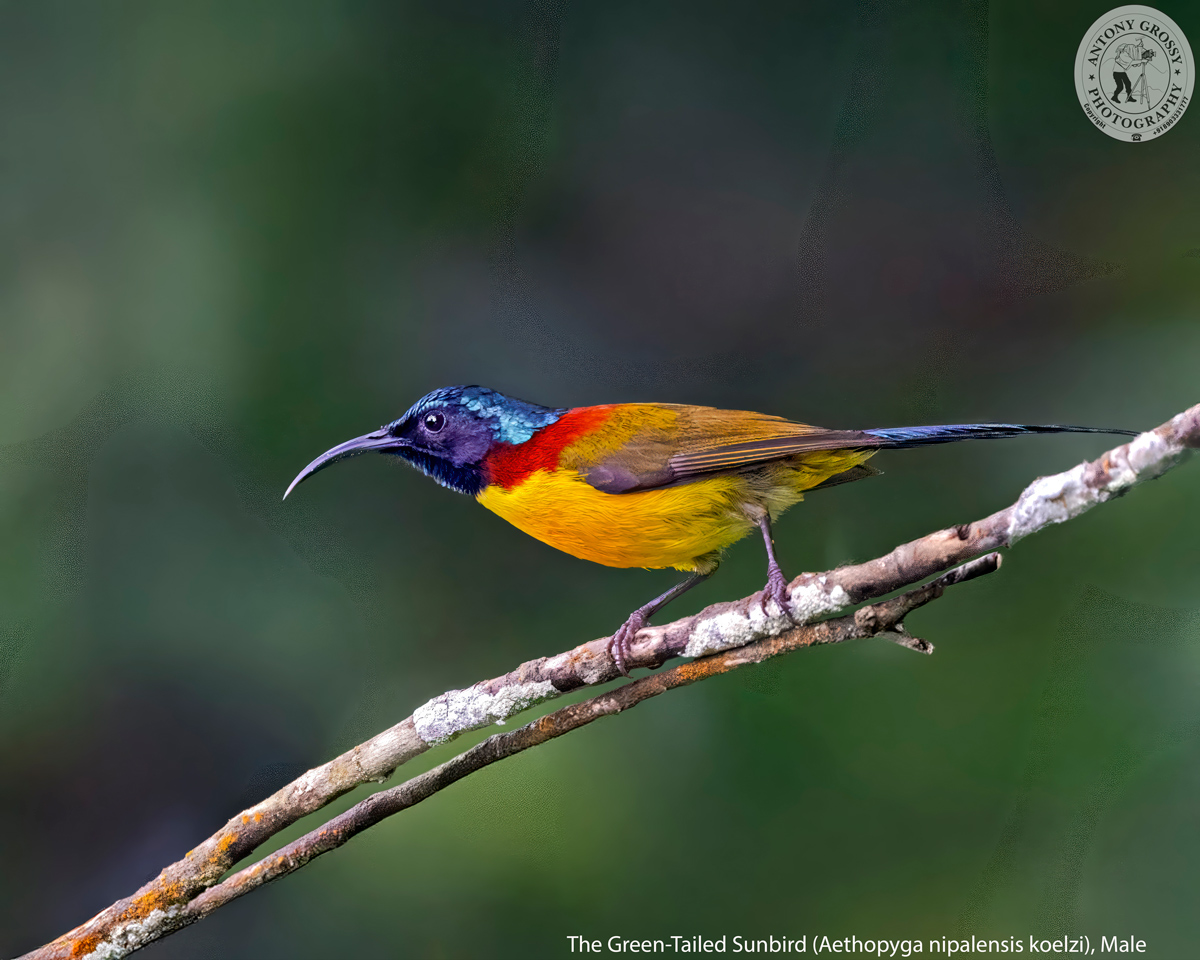

|
 |
| Where Do You See the Green Tail – The Green-Tailed Sunbird, Male |
| The Green Tailed Sunbird also called The Nepal Yellow Backed Sunbird is a species of sunbird found in the Northern regions of the Indian subcontinent, stretching Eastwards into parts of Southeast Asia. The male is attractively coloured while the female is rather drab looking. . . . . . . . . . . . . . . . . . . . . . . . .. .. …. ……. . .. … …… ………………………. ………….. ……………….. .. …. …. ……….. … …. ……….. … …. ………… ………….. ………… ………… ….. ………. …………. …….. ……………. …… …. …. ……….. … …. ……….. .. ………… ….. ………. …………. …….. …… The Green Tailed Sunbird males bright greenish-blue head is much more noticeable than his tail. Also note his red upper back and bright yellow underparts. Female is olive-yellow with paler underparts and a greyish head. Note the lack of a strongly contrasting pale rump patch as compared to female Mrs. Goulds Sunbird. The Male measures between 14 to 15 cm and weighs about 5·5 to 8 gms whereas the female measures about 10 cm with a weight of 5·4 to 6·5 gms. It is a long-tailed sunbird with rather long, heavy-based curved bill. The Male has a crown, nape, uppertail-coverts and graduated tail metallic green to blue-green, tail white-tipped (visible from below) and with elongated central feathers; side of neck and upper back crimson-brown or maroon, upperwing and middle of back olive-green, lower back yellow, rump bright yellow; cheek blackish glossed purple or violet, throat metallic green, underparts bright yellow, streaked scarlet on breast; iris dark brown or reddish-brown; bill and legs black or dark brown, underside of toes paler. The Female is olive-green, greyer on head, slightly yellowish below; feathers of graduated tail except central pair (and sometimes adjacent pair) variably tipped white, sometimes almost no white tipping at all; bare parts as male. The Juvenile is similar to the female, but has greener crown, is yellower below, has less graduated tail with less obvious pale tips; young male is washed orange on breast, later developing green nape, maroon scapulars and elongated tail feathers. The Race koelzi has longer bill than nominate, male has smaller yellow patch on lower back and rump, female has olive crown and nape and a hint of yellow on rump. There are Nine subspecies recognized. . . . . . . . . . . . . . . . . . . . . . . . .. .. …. ……. . .. … …… ………………………. ………….. ……………….. .. …. …. ……….. … …. ……….. … …. ………… ………….. ………… ………… ….. ………. …………. …….. ……………. …… …. …. ……….. … …. ……….. .. ………… ….. ………. …………. …….. …… The Green Tailed Sunbird is found in Nepal and the Northern regions of the Indian subcontinent, stretching Eastwards into parts of Southeast Asia. They are found in various forest types, including primary forests (such as submontane and montane), woodland, scrub-jungle, among rhododendrons, around flowering trees, in secondary growth, orchards and gardens; 300 to 3665 mtr, lower in winter. Inhabits montane and hill forests and forest edge. . . . . . . . . . . . . . . . . . . . . . . . .. .. …. ……. . .. … …… ………………………. ………….. ……………….. .. …. …. ……….. … …. ……….. … …. ………… ………….. ………… ………… ….. ………. …………. …….. ……………. …… …. …. ……….. … …. ……….. .. ………… ….. ………. …………. …….. …… Food thought to be small arthropods and nectar. Forages singly and in small, loose groups; often in canopy, but also at lower levels. . . . . . . . . . . . . . . . . . . . . . . . .. .. …. ……. . .. … …… ………………………. ………….. ……………….. .. …. …. ……….. … …. ……….. … …. ………… ………….. ………… ………… ….. ………. …………. …….. ……………. …… …. …. ……….. … …. ……….. .. ………… ….. ………. …………. …….. …… Their song is tchiss tchiss-iss-iss-iss, beginning high, then a low note, followed by a rising one, and finally by high notes; also described as a lively switititititititit twitter mixed with sharp, high swi, tis and tsi notes, and as a dry metallic trill. Calls include sharp dzit or reet, twit-zig-zig, a frequently repeated tee-tzree-tzweeeet, and series of hard, staccato stip notes. …. ………. …… ………….. ………… ………… …. … … …… ………….. ………… ………… ….. ………………….. … ………… ….. ………. …… ………….. …………………….. … ………… ….. ………. …… ……. ………….. ………….. …… ………….. ………….. ………. …………………… ………….. …… ………….. ………….. ………. …………. ….. ………. …… ………… ………….. ………….. ….. ………. …….. ………… ………….. ….. ……….. …… ………….. ………… ……….. Description Credit Birds of the World (The Cornell Lab), Oiseaux, Birda, Animalia, Ogaclicks, Birds of India | Bird World, Bird Count India & Wiki. |
  |
|
|
















































































































































































































































































































































































































































































































































































































































